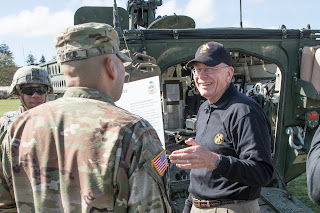‘Ghost Brigade’ holds change of command ceremony
By Maj. Kelly Haux
JOINT BASE LEWIS-MCCHORD, Wash. – The 1st Stryker Brigade Combat Team “Ghost Brigade,” 2nd Infantry Division welcomed a new commander at Joint Base Lewis-McChord, Wash., with a change of command ceremony at Watkins Field Jun 8, 2017.
Col. Jasper Jeffers assumed duties as the commander, replacing Col. David Foley as the commander of the Ghost Brigade.
Maj. Gen. Thomas James, the 7th Infantry Division commander, described Jeffers as a man equal to the task of carrying on the legacy of the Ghost Brigade and Jeffers arrives at command with combat experience from Iraq, Afghanistan, North and West Africa as well as other locations throughout the Middle-East.
“His predecessor, Col. Foley, aggressively built mission command,” said James, “which allowed the Ghost Brigade team to attend two decisive action rotations at the National Training center within 10 months, enhanced readiness through deploying formations to exercise Yudh Abhyas in India and on JBLM, plus simultaneously building interoperability with partnered nations in the Pacific Region through two Pacific Pathways iterations.”
For Foley, the change of command ceremony was the opportunity to reflect upon the lineage of the 1-2 SBCT as well as the brigade’s accomplishments.
“Over the course of this command,” said Foley, “I’ve watched with admiration as these ghost Soldiers have not only evolved into a contemporary Stryker brigade combat team, but also conducted countless operations, administrative requirements, and training initiatives in support of a multi-faceted operational strategy that justly encapsulates the strength of this Stryker warfighting formation.
“They have developed strong community partnerships and a health of the force campaign in support of both a comprehensive leader development strategy and the indoctrinated tenets of a values-based learning organization,” Foley added. “All of these major accomplishments could not have been realized without the strong support of the magnificent officers, non-commissioned officers and Soldiers in the bayonet division.”
Foley highlighted what he believes is the single most important element of the formation: the Soldiers and their development as leaders of character.
“The Soldiers of this brigade are the best the Army has to offer,” Foley said. “They are empowered leaders of character who possess the moral courage to do the right thing, who operate on disciplined initiative, fight and care for each other….and they do not quit.
“They emulate the Officer/NCO team as the centerpiece for accomplishing tasks to standard and for developing individual and unit strength of character,” he said. “Their physical and mental toughness is the cornerstone for ensuring competent, confident leaders, for inspiring a winning spirit and for achieving the kind of readiness essential to providing lethal and adaptable force projection in support of future national security requirements.”
This brigade change of command is the most recent in a series of changes within the subordinate battalions in the unit. Five of the six battalions that make up the Ghost Brigade changed command within recent months, with the final battalion scheduled to change in the near future.
JOINT BASE LEWIS-MCCHORD, Wash. – The 1st Stryker Brigade Combat Team “Ghost Brigade,” 2nd Infantry Division welcomed a new commander at Joint Base Lewis-McChord, Wash., with a change of command ceremony at Watkins Field Jun 8, 2017.
Col. Jasper Jeffers assumed duties as the commander, replacing Col. David Foley as the commander of the Ghost Brigade.
Maj. Gen. Thomas James, the 7th Infantry Division commander, described Jeffers as a man equal to the task of carrying on the legacy of the Ghost Brigade and Jeffers arrives at command with combat experience from Iraq, Afghanistan, North and West Africa as well as other locations throughout the Middle-East.
“His predecessor, Col. Foley, aggressively built mission command,” said James, “which allowed the Ghost Brigade team to attend two decisive action rotations at the National Training center within 10 months, enhanced readiness through deploying formations to exercise Yudh Abhyas in India and on JBLM, plus simultaneously building interoperability with partnered nations in the Pacific Region through two Pacific Pathways iterations.”
For Foley, the change of command ceremony was the opportunity to reflect upon the lineage of the 1-2 SBCT as well as the brigade’s accomplishments.
“Over the course of this command,” said Foley, “I’ve watched with admiration as these ghost Soldiers have not only evolved into a contemporary Stryker brigade combat team, but also conducted countless operations, administrative requirements, and training initiatives in support of a multi-faceted operational strategy that justly encapsulates the strength of this Stryker warfighting formation.
“They have developed strong community partnerships and a health of the force campaign in support of both a comprehensive leader development strategy and the indoctrinated tenets of a values-based learning organization,” Foley added. “All of these major accomplishments could not have been realized without the strong support of the magnificent officers, non-commissioned officers and Soldiers in the bayonet division.”
Foley highlighted what he believes is the single most important element of the formation: the Soldiers and their development as leaders of character.
“The Soldiers of this brigade are the best the Army has to offer,” Foley said. “They are empowered leaders of character who possess the moral courage to do the right thing, who operate on disciplined initiative, fight and care for each other….and they do not quit.
“They emulate the Officer/NCO team as the centerpiece for accomplishing tasks to standard and for developing individual and unit strength of character,” he said. “Their physical and mental toughness is the cornerstone for ensuring competent, confident leaders, for inspiring a winning spirit and for achieving the kind of readiness essential to providing lethal and adaptable force projection in support of future national security requirements.”
This brigade change of command is the most recent in a series of changes within the subordinate battalions in the unit. Five of the six battalions that make up the Ghost Brigade changed command within recent months, with the final battalion scheduled to change in the near future.













